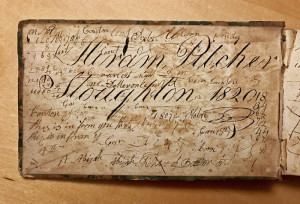True Tales Excerpt: Hiram’s Notes
By George T. ComeauThe following is an excerpt from “Hiram’s Notes,” the latest installment of True Tales from Canton’s Past by local historian George T. Comeau.
It is indeed curious to look upon seemingly random jottings and build a portrait of a person whom we have never met. It’s a simple gesture, a note that records the cycle of life in rural Canton. Here is a book in our hands that records the comings and goings of family, the planting of seeds, the coming of the frost and the waning of the snow. The book lends plenty of mystery that will never be solved, only because there are no longer certain keys to unlock the past.

The inside front cover of Hiram Pitcher’s notebook that he began in 1820 (Courtesy of the Canton Historical Society)
In this case, a boy of 12 or 13 by the name of Hiram Pitcher began making notes in 1820 and continued his notes until 1838. Pitcher was the fourth of 10 children born to Abigah Pitcher and Rebekah Bailey. There were a lot of Pitchers from the area in the mid to late 18th century. Hiram’s grandfather was likely born in Stoughton, and his great-grandfather by the name of Eliakim was born in Dorchester in 1709. By 1720, the Pitcher family was in Stoughton, which would make them among the earliest settlers of what is now Canton. Hiram’s grandfather served in the Revolutionary War after the alarm at Lexington.
The great-grandfather, Eliakim Pitcher, was listed among the “alarm-men” of a local militia formed in 1757. He also owned property along Pleasant Street and had a house on what is now Pine Street. A fascinating man, he is noted for his calm under duress. Most notably, on the morning of May 19, 1780, Pitcher found himself shearing sheep near his home. Halfway through the morning the sky turned yellow and the animals began to make cover for darkness. By lunchtime a total darkness descended over all of New England and eastern Canada. To this day there is no plausible explanation for what became known as the Dark Day. There are plenty of theories. Perhaps it was the result of a volcanic eruption, or fires or even a meteor strike. Nevertheless, as this deeply pious town was plunged into biblical darkness, the farmers left their fields, and children left their schoolhouses quite frightened.
The historical record on the subject of the Dark Day calls out Eliakim Pitcher in particular: “He was sheering sheep when the darkness came; he quietly called for candles, and worked all day as if nothing unusual was going on.” Such was the unflappable quality of the Pitcher family.
And so, inside this little notebook of antique pages in the handwriting of Hiram Pitcher is a matter-of-fact recording of his year-to-year observations made 200 years ago. Some of the entries are quite simple. Hiram notes that he gave his mother one seine of thread, and three and a third yards of flannel along with a yard and a third of “shambre.” He also makes note of the fact that he sold or gave 30 crackers away.
The entries for 1824 and 1825 are still financial in nature. “Settled with Mr. John Mansfield in his house on Saterday.” And on April 19 he noted that he “bought of Dudley Bailey one hundred and twenty weight of pork at eight cents a pound.” We now begin to see more of Hiram’s flickers of life in Canton …
See this week’s Canton Citizen to read the full version of this story. Not a subscriber? Click here to order your subscription today (also available in digital form).
Short URL: https://www.thecantoncitizen.com/?p=37611










